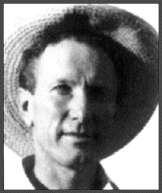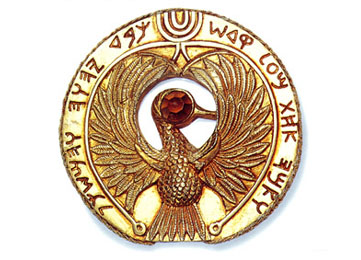
PETER HURD, the world-renowned western artist, was born in Roswell, New Mexico, on February 22, 1904. His parents named him Harold Hurd, Jr., but called him Pete, and in his early twenties he legally changed his name to Peter. The elder Hurd came from a prominent Boston family, graduated from Columbia University Law School, and established his legal practice in New York City. Peter Hurd grew up in Roswell, where his parents settled for health reasons. Following three years of high school at New Mexico Military Institute in Roswell, Hurd was accepted as a cadet by the United States Military Academy at West Point. He entered as a plebe in July 1921, at the age of seventeen. Within two years, however, he was disillusioned by the rigors and values of military life and was drawn increasingly to art. In 1923 he resigned from West Point in good standing, with his father's reluctant consent. He transferred to Haverford College, where he studied the liberal arts and devoted himself to painting. In December 1923, in Chadds Ford, Pennsylvania, Hurd became acquainted with N. C. Wyeth, an illustrator of children's classics and the father of Andrew Wyeth. He persuaded Wyeth to accept him as a pupil in the spring of 1924. Hurd soon fell in love with Wyeth's eldest daughter, Henriette, herself an excellent painter. In June 1929 they married.
Hurd first attained national fame in the late 1930s, some through his efforts with the WPA. Over the next four decades he earned many awards and distinctions. During World War II he served as a war-correspondent artist for Life magazine and received the European Theater Medal for Service Overseas in 1947. Below is an example of one of Hurd's works done as a war-correspondent artist, executed by him in the field while serving in the China-Burma-India theater:
B-29 IN INDIA SUPPORTING OPERATION MATTERHORN. PAINTING BY PETER HURD
(please click image)
My Uncle was a fellow New Mexico WPA artist colleague and friend of Hurd. When Hurd was in India creating paintings similar to the one above he met a 23 year old B-29 pilot named John Noble Cumming. Before the war Cumming was an artist and muralist assistant for the great Mexican muralist Diego Rivera. So respected was Cumming's work by Rivera he included his image in the 15.75 foot high by 37.5 foot long mural "Man Controller of the Universe" he painted in the museum in Mexico City. Cumming was killed two weeks before his 24th birthday when his Superfortress crashed during a "hump" related bombing run over the Himalayas headed toward Japan in World War II.
After World War II, Hurd's attention returned to southeastern New Mexico where, among other things, he introduced a hitherto unknown archaeological site (the Bonnell site) in the Hondo River Valley to his good friend Professor William Curry Holden, an eminent scholar who in later years wrote extensively on the Yaqui Indians of Sonora. Oddly enough, in 1947, in a curious twist of fate, according to Roswell Incident: Updated, as well as other similar sources, while on an archaeological dig in a nearby area of the desert Professor Holden became caught up in the infamous ROSWELL UFO legend, the mysterious but unknown craft that supposedly crashed down near Hurd's birthplace and hometown of Roswell scattering metal parts and debris over a wide area.
CITY OF ROSWELL, CIRCA 1947
In 1959 Hurd was appointed to the Commission on Fine Arts by President Dwight D. Eisenhower and in 1966 he painted the official portrait of President Lyndon B. Johnson. It now hangs in the National Portrait Gallery in Washington. Hurd's art has been exhibited in museums throughout the country and is part of many permanent collections. He worked in a variety of media, including oil, lithography, watercolor, egg tempera, charcoal, and fresco. The most notable of his mural paintings depicting the history of southwestern life can be seen in Lubbock, Dallas, and Big Spring, Texas. Hurd achieved the best expression of his personal vision in the tempera paintings of the place he loved best-the small village of San Patricio, New Mexico, fifty miles west of Roswell, where he built Sentinel Ranch in the 1930s. Painting on panels covered with several coats of gesso, Hurd captured the drama of light and shadow on the hills and the vastness of sky and plain in every kind of weather.
He published a variety of magazine articles, not only on art but on other subjects ranging from polo (he was an outstanding horseman) to soil and land conservation, an issue to which he was passionately committed. In a life of painting, ranching, farming, polo playing, and other pursuits, the Hurds brought up three children who achieved distinction in the arts.
Peter Hurd died on July 9, 1984, not far from his birthplace in Roswell.
See as well sometimes fellow New Mexico artist John Sloan, also known to have a strong creative insight into the use of tempera.
THE SPIRITUAL ELDER AND THE SANTA FE CHIEF
WPA FEDERAL WRITERS’ PROJECT
ROSWELL I-BEAM HIEROGLYPHS
THE ARTIST IN ME
OUTER SPACE TO THE RENAISSANCE UFOs
(please click image)
BIBLIOGRAPHY: Paul Horgan, Peter Hurd: A Portrait Sketch from Life (Austin: University of Texas Press, 1964). Peter Hurd, Peter Hurd: The Lithographs (Lubbock: Baker Gallery, 1968). Peter Hurd, Peter Hurd: Sketch Book (Chicago: Swallow, 1971). Robert Metzger, My Land is the Southwest: Peter Hurd Letters and Journals (College Station: Texas A&M University Press, 1983).
BIOGRAPHICAL INFORMATION AND GRAPHIC
PROVIDED AS WELL THROUGH THE COURTESY OF:
